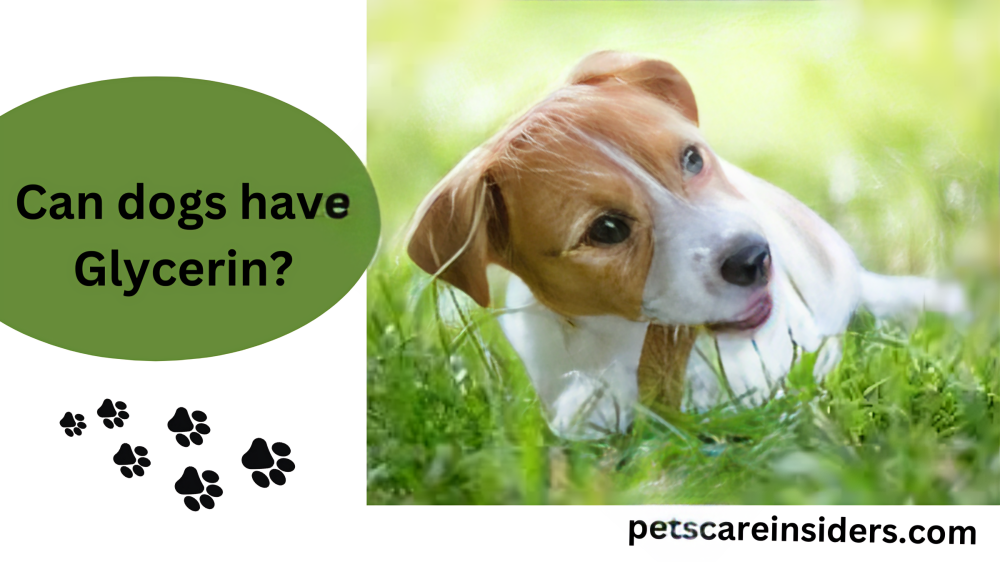Sugar alcohols include glycerin, which is a Glycerite substance used in conjunction with herbs or medication. Vegetables, animal fats, and petroleum byproducts are just a few of the familiar sources of glycerin. Glycerin was once thought of as only a byproduct of soap production because most people associate it with soap. It’s important to consider whether dogs have glycerin and how it may affect their health.
Glycerin, a sweet, colorless, odorless liquid, is a common ingredient in many products, including foods, medications, vitamins, and cosmetics. Its ability to mask the taste of unappealing supplements makes it a popular choice. However, the quality and purity of glycerin can vary, making it essential for consumers to be discerning about the source of their products and to distinguish between high-quality, safe products and low-quality, dangerous ones.
Uses of Glycerin in Dog Products
Glycerin’s many uses make it a popular ingredient in many dog products. Among the principal applications are the following:
Treats for Dogs
Treats for dogs frequently include glycerin for several reasons:
- Moisture Retention: Keeping treats chewy and moist makes them more enticing to dogs.
- Preservation: It serves as a preservative, extending the sweets’ shelf life by keeping them from going bad or drying out.
- Sweetening Agent: Because of their sweetness, you don’t need to add sugar to make the snacks taste better.
Chewable Dental
Glycerin has several uses in dental chews:
- Texture: It minimizes plaque and tartar while preserving a malleable texture that is kind to dogs’ teeth and gums.
- Binding Agent: It facilitates the binding of other constituents, resulting in a homogeneous and steady-state product.
Supplements and Medications
Glycerin is frequently used in dog vitamins and treatments to distribute active substances uniformly and enhance palatability. Quality and source are essential for safety and efficacy. Talk with your veterinarian for advice on the dose and possible adverse effects of giving your dog products with glycerin.
Is Glycerin Safe for Dogs?
Glycerin is generally safe for dogs when made from premium vegetable-based materials and used sparingly. It is frequently used as a moisture-retaining and sweetening ingredient in dog treats, dental chews, and grooming products.
Nevertheless, overindulgence may result in stomach problems, so it’s critical to adhere to product recommendations and see a veterinarian if you have any concerns. Glycerin is a helpful ingredient in many pet products, provided it is of reliable quality, to reduce potential hazards.
Types of Glycerin: Vegetable-Based vs. Synthetic
Glycerin Made from Vegetables
Plant oils like coconut, soy, or palm oil are hydrolyzed to produce glycerin with a vegetable base. The glycerin is then separated from the fatty acids. It is prized for its natural origin and safety and is frequently used in culinary items, cosmetics, pharmaceuticals, and pet products.
Its hydrating and humectant qualities make it a safe, non-toxic skin and hair care option. It is preferred in natural, organic, and vegan products because it doesn’t include any components originating from animals.
Synthetic Glycerin
Chemical reactions involving petroleum-based raw materials, such as the epoxidation of allyl chloride or the chlorination of propylene, are used to make synthetic glycerin. It can be found in several food and cosmetic goods and industrial uses such as resins, plastics, and antifreeze.
However, it could be better for old and personal hygiene items, as they contain contaminants and provide health hazards. Because of possible safety issues, synthetic glycerin is less favored for pet products than natural or organic goods.
Benefits of dogs have glycerin
When utilized in dog products, glycerin provides many advantages. It acts as a moisture-retaining agent, preserving dog treats’ chewy texture and allure. Furthermore, without the harmful effects of sugar, its sweet taste improves palatability. As a preservative, glycerin keeps things from drying out or going wrong, prolonging their shelf life. Because of these qualities, it is valuable for preserving the attractiveness and quality of different dog treats and mouth hygiene products.
Potential Risks and Side Effects of dogs have glycerin
While glycerin is generally safe, dog owners must know the potential risks and side effects. Overfeeding can lead to stomach irritation or diarrhea, so monitoring the amount of glycerin in treats and chews is crucial. Choosing high-quality glycerin, preferably from vegetables, can help prevent health hazards from synthetic or inferior sources. It’s best to consult your veterinarian if your dog exhibits any negative responses.
Alternatives to Glycerin in Dog Treats
Dog treats can contain several substitutes for glycerin, including:
- Natural Sweeteners: You can get sweetness and moisture from ingredients like honey or molasses without using glycerin.
- Applesauce: provides natural moisture and binding to baked goods.
- Peanut butter gives handmade sweets a taste and aids in binding ingredients.
- Coconut oil: provides an excellent source of healthy fat and aids ingredient binding.
- Yogurt: Especially in frozen foods, it adds flavor and smoothness.
Consulting Your Veterinarian
Your veterinarian’s personalized advice regarding your dog’s health and nutritional needs is invaluable. They can recommend suitable treats, monitor for adverse reactions, and suggest substitutions or adjustments based on your dog’s needs. Maintaining your dog’s general health and well-being requires routine trips to the veterinarian.
Monitoring Your Dog’s Health
Monitoring your dog’s health is crucial when introducing glycerin treats to your dog, especially for the first time. Look for any signs of stomach distress, such as vomiting or diarrhea. Ask for advice from your veterinarian if you observe any adverse effects. Adjust the types or amounts of treats based on your dog’s reaction to ensure your dog’s happiness and well-being.
Conclusion
Glycerin, when used sparingly and from premium vegetable-based sources, can improve the look and durability of dog treats. It’s crucial to keep an eye on your dog’s reaction to avoid stomach problems, and speaking with your veterinarian guarantees that your dog’s health and welfare come first. This method lets you give your dog fun treats without compromising their general health, all while carefully introducing glycerin or other substances into their food.
